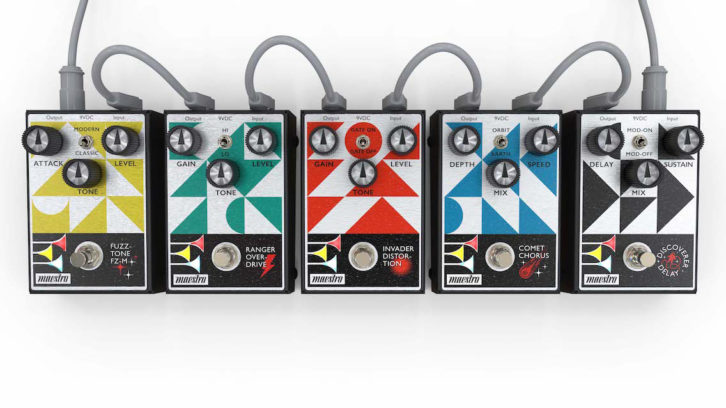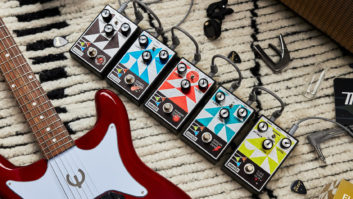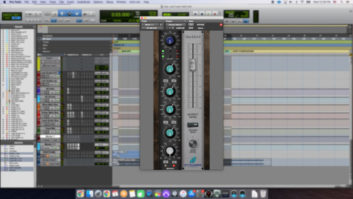 Gibson’s release of the Maestro Original Collection marks the comeback of a long-dormant, legendary brand of effects pedals and units. The new line consists of five stompboxes designed to harken back to the sounds of the 1960s and 1970s, when the original Maestro pedals were in vogue. The first Maestro effects pedal, the FZ-1 Fuzz-Tone, hit the market 60 years ago, back in 1962, then took off in 1965 when Keith Richards used it for the main riff in the Rolling Stones hit “Satisfaction.”
Gibson’s release of the Maestro Original Collection marks the comeback of a long-dormant, legendary brand of effects pedals and units. The new line consists of five stompboxes designed to harken back to the sounds of the 1960s and 1970s, when the original Maestro pedals were in vogue. The first Maestro effects pedal, the FZ-1 Fuzz-Tone, hit the market 60 years ago, back in 1962, then took off in 1965 when Keith Richards used it for the main riff in the Rolling Stones hit “Satisfaction.”
During its first incarnation, Maestro was also responsible for the Boomerang Wah and several versions of the Echoplex tape delay—the tube-based EP-1 and EP2, and the solid-state EP-3 and EP 4. In the early 1970s, Maestro released the RM-1 Ring Modulator and PS-1 Phase Shifter pedals. Both were designed by a young Tom Oberheim. Maestro continued to produce effects pedals until it was shuttered in 1979 by Norlin, the company that then owned Gibson.
Now, 43 years later, Gibson has brought the Maestro brand back. The new pedals offer all-analog circuitry with true-bypass switching, and tone that brings you back to the products of the original Maestro era. The new pedals include Invader Distortion, Fuzz-Tone FZ-M, Ranger Overdrive, Discoverer Delay and Comet Chorus. I had the opportunity to test all five pedals for this review.
COMMONALITIES
The first thing that struck me when looking at the Maestro Original Collection pedals as a group was their similarities. All five pedals are the same size and are housed in a sturdy metal casing. All have the same physical configuration of knobs and switches: a footswitch, three knobs and a toggle switch. The latter lets you change to a second operating mode on all but one of the pedals, providing additional functionality.
The pedals are powered by a standard 9V adapter (not included) or a battery, and feature a Maestro logo on the bottom left, replete with red, yellow and blue trumpets that light up when the unit is engaged. Each pedal has its own color scheme.
FUZZ-TONE FZ-M
Loosely based on the original FZ-1, the Fuzz-Tone FZ-M provides an impressive selection of buzzy, distorted tones. Its three control knobs are Attack, Tone and Level. Attack governs the amount of fuzz and clipping, Tone handles EQ and Level is the master output volume.
The toggle lets you switch between Classic and Modern mode. Classic is thinner and sharper-sounding, while Modern is fuller and warmer. I found Classic generally sounded best with the Tone knob set somewhere below 12 o’clock, and Modern with it somewhere above. Otherwise, the former was too bright and the latter too round. Overall, I prefer the Modern tone, but I could see where Classic would come in handy if you wanted a cutting and raw sound.
I found the FZ-M to be a little tamer than expected when cranked, with less natural compression and harmonics. Its sustain wasn’t near-infinite like it is on many fuzz pedals. Nevertheless, it sounds good on both low and high-gain settings. It would be a valuable addition to any pedalboard.
INVADER DISTORTION
Invader Distortion offers even heavier saturation than the Fuzz-Tone FZ-M and makes your guitar instantly sound like it’s coming through a superhigh- gain amp. Its controls include Gain, Tone and Level. Its toggle switch kicks in a noise gate, which silences the hum and buzz you can get on high settings with this or any other heavy distortion pedal.
You can change the Gate Threshold, but doing so requires removal of the four screws on the unit to open up its back plate. The attack and release are fixed, which somewhat limits the gate’s utility. At its stock setting, it cuts off pretty quickly and unnaturally. I wouldn’t use it in a song where my part was highly dynamic because it could cut off as a note or chord is ringing out. But for keeping things quiet when you’re not playing, or in between songs, the Gate feature is handy.
Sound Anchors ADJ2 Speaker Stands – A Real-World Review
Invader Distortion is surprisingly versatile and could handle all of your distortion needs on a gig. I liked both the heavy and lighter distortion it produces. With the Gain knob set anywhere from its lowest point to about 25 percent, you get a warm and crunchy amp-like tone. Settings above that get you into high-gain land.
The (output) Level control is useful for compensating the output level when you turn up or down the Gain.
RANGER OVERDRIVE
Probably the most “tubey” sounding of the three distortion pedals in this collection, the Ranger Overdrive gives you a lot of warm tone in the low-to-medium gain area. Like Invader Distortion, it has Gain, Tone and Level knobs. Its Mode toggle switches between Hi and Lo gain settings.
Set it on Lo with a relatively low Gain setting and it gives you a nice, amp-style breakup that would be great as a “set and forget” effect that you leave on continuously to add crunch to a clean amp. But when you turn the Gain knob up, it gives you a moderately distorted lead tone that would be great for blues or country or roots rock.
If you used it in a signal chain with a compressor or gain boost, you could push it to get even heavier. No matter how you set it, though, its warm tone is quite pleasing.
COMET CHORUS
The Comet Chorus offers two operating modes. With the Mode toggle set in the downward Earth position, it gives you what the manual refers to as an “optimized, classic heavenly chorus effect.” Set to Orbit mode, it produces pulsing vibrato and rotary speaker–style effects. The adjustable parameters include Depth, Mix and Speed. An internal trim pot lets you adjust the amount of rotary speaker effect.
I definitely liked the effects in Orbit mode. The vibrato is rich and variable, and the rotary speaker sounds are authentic and pleasing. Having the Mix control is useful for adjusting intensity when you’re happy with the Speed and Depth settings.
I wasn’t as impressed with Earth mode. The straight chorus sounds didn’t have the richness I’m used to in a chorus effect. Chorus typically combines both delay and pitch modulation, but on this pedal, it sounds like there’s mostly the latter and not enough of the former. Don’t get me wrong; it doesn’t sound bad, but it lacks the complexity and warmth I was expecting. I compared it with other chorus pedals I have, which confirmed my initial reactions.
All that said, it’s still a versatile modulation pedal; it’s just better at creating vibrato and Leslie-style effects than it is at chorusing.
DISCOVERER DELAY
If you like analog delay, you’ll love this pedal. Controls include Delay, Mix and Sustain (feedback), and you can switch in modulation using the Mode toggle. The unit provides between 20 ms and 600 ms of delay. As you’d expect with analog delay, the brightness dissipates with each successive tap.
The first time I tried out this pedal with a guitar and amp, I lost track of time as I reveled in the rich-sounding analog delay it produces. The name Discoverer feels accurate because it inspires creativity and experimentation.
Turning on the modulation adds another layer to the sound. You can set it to be subtle or heavy-handed, depending on how you set the internal Width and Rate trim pots.
OPEN AND SHUT CASE
Maestro’s decision to build all the pedals with the same architecture of three knobs and a Mode toggle is a mixed bag, I found. On the plus side, it allowed the company to manufacture the units more inexpensively due to the economies of scale.
However, putting additional controls on internal trim pots on the Comet Chorus, Discoverer Delay and Invader Distortion is not convenient for the user. If you’re planning to use the pedals for live performance, that makes it virtually impossible to adjust the trim pots on a song-by-song basis. All you can do is set and forget your preferred setting.
I wish Maestro had made the trim-pot parameters adjustable via additional knobs on the face of the pedals. It would be worth paying a little more to have those controls available at any time, rather than only when you have the case open.
But my overall takeaway on the Maestro Original Collection is extremely positive. They’re solidly built, reasonably priced and offer plenty of sonic versatility. Other than my issue with the Earth Mode on the Comet Chorus, I found the effects they create to be authentic-sounding and their tonal quality to be pleasing. If you’re looking for distortion, modulation or delay pedals for your setup, I’d recommend checking them out.







